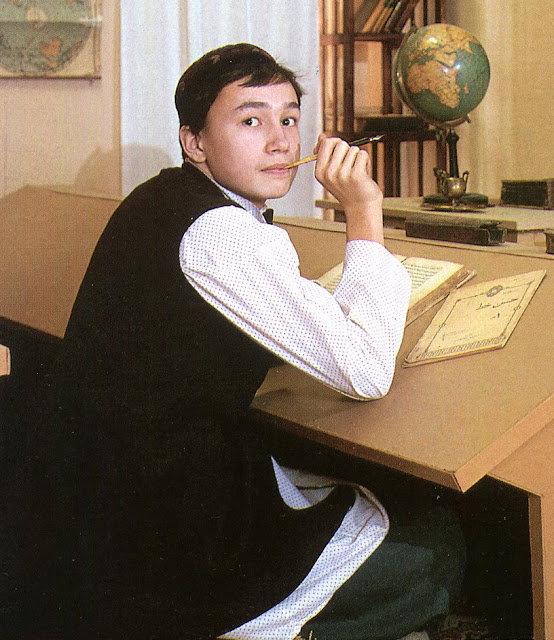One of my pet peeves is that men's costume gets short shrift in most publications, and i am finding that i am doing it as well. The fact is that for most peoples, there is less to say about men's clothing. And often less is known, since men tend to give up their costume faster and easier than women do. [With some notable exceptions, the Scottish Highland kilt and the Greek/Albanian Foustanella come to mind].
So today i will continue my series on the costumes of Tatarstan by paying attention to the men. Here again is the painting by Pauli of the Kazan' Tatar costume. Notice the man is sort of hiding in back. The city costume and the peasant costume for men was the same, differing only in the materials used.
What we can see is shirt, vest, jacket, pants, slippers and hat. The shirt, kulmege, is one very typical of the Turkic peoples, with a central opening, standing collar, and tunic shaped cut.
The shirt is made of linen or cotton, white or with a fine striped or dotted design. Here is a photo of one such shirt.
Here is a photo of some men in the village. If you look carefully, you can see stripes on one shirt, and dots on the other. The man on the left is wearing a beshmet, a padded quilted jacket.
Two pairs of pants are worn, the first of a light material, the 'underpants', and the second of a heavier weight cloth. This is very common. The cut is one typical of the Turkic peoples, called 'khatyn-kyz', or 'wide-stride', because the central gusset is very wide. They are gathered on a drawstring, and give ample room for movement, whether on horseback or otherwise. Here is the cut.
And here is a photo of some typical examples.
In the villages they used stiped homespun, or plain dark wool in colder weather. Over these is worn the kamzul, as in the woman's costume, but it is usually worn closed, and as you can see from the gentlemen above, is double breasted, the right side overlapping the left. They generally extended to mid-thigh. The cloth used varied a great deal according to the wealth of the wearer and the occasion. Here is a well to do city man ready for a moderately special occasian. In this photo you can see the placement of the buttons, which are not done up.
Sometimes the shirt was worn tucked in, as this man shows us.
And sometimes worn outside the pants, as this student is doing.
Generally when going out in public, a jacket of identical cut, only with sleeves and longer, was worn over the kamzul, called the kazakin, or if padded and quilted, the beshmet. Both the jacket and the vest had a fitted cut. Here is the cut of the vest and jacket.. It is very similar to the woman's kamzul.
And here is a city man wearing a dress kazakin, the vest being visible at the neck. The second photo shows a more day to day version. The same cut was used for heavy coats in the wirnter as well.
On especially grand occasions, a different jacket was worn which recalls the central Asian khalat. It is called the djilen. It is not fitted and was often made of extremely ornate materials as in this example.
You will notice that his shirt is also made of ornate material and has a fold down collar. A cap is always worn, most Tatars being of the Muslim faith. The cap, kelepush, can be hemispherical or truncated cone shaped, plain or highly embroidered, with a tassel or without. The above photos give some examples, Here are a few more.
Slippers were worn indoors, boots outdoors. Villagers would wear footcloths and lapty, [shoes woven of birch or linden bark]. In heavy snow, valenki [felt boots] would be worn. Here are some indoor slippers, made with the famous Tatar 'leather mosaic' technique, a type of patchwork. You can see the man in the splendid djilen above wearing these.
Here is an example of a boot done in the 'leather mosaic' technique. Solid color boots are also worn.
An example of a unique and amazing craft.
Thank you for reading, aa always, and i hope that you found this informative.
Feel
free to contact me with requests for research. I hope to eventually
cover all of Europe and the Former Russian Empire/Soviet Union. I also
gratefully accept tips on source materials which i may not have. I also
accept commissions to research/design, sew, and/or embroider costumes or
other items for groups or individuals.
Roman K.Rkozakand@aol.com
Source Material:
M. Zavyalova, 'Tatar Milli Kieme' [Tatar Costume], Kazan', 1996
Guzel Valeeva-Suleimanova, 'The Decorative Applied Art of the Kazan' Tatars', Moscow, 1990
E. Korneev, 'Costumes of the Peoples of Russia in the Graphic Arts of the 18th-20th centuries', Moscow, 1990
N. Kalashnikova, 'National Costumes of the Soviet Peoples', Moscow, 1990
F. Safina, 'Tkachestvo Tatar Povolzia i Urala' [Weaving of the Tatars of the Volga and Urals], Kazan', 1996


















Very interesting. Great pictures!
ReplyDeleteLovely! Thanks for introducing me to a new style of dress.
ReplyDeletebeautiful costumes...I see similarities to the Inu, the Hans, and many other asians..
ReplyDelete